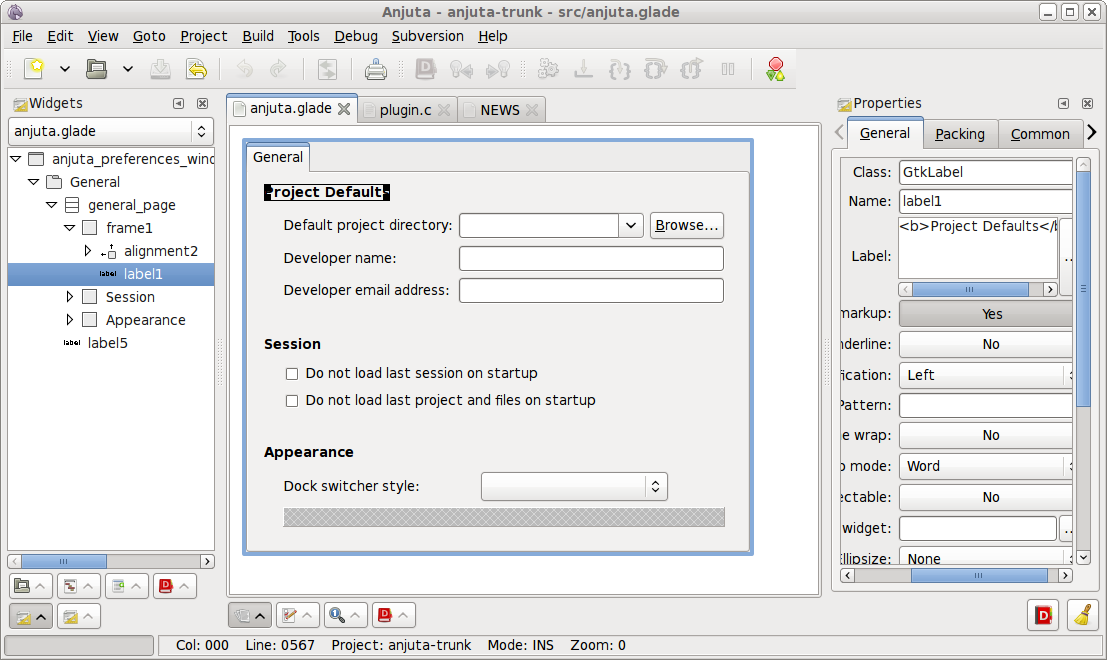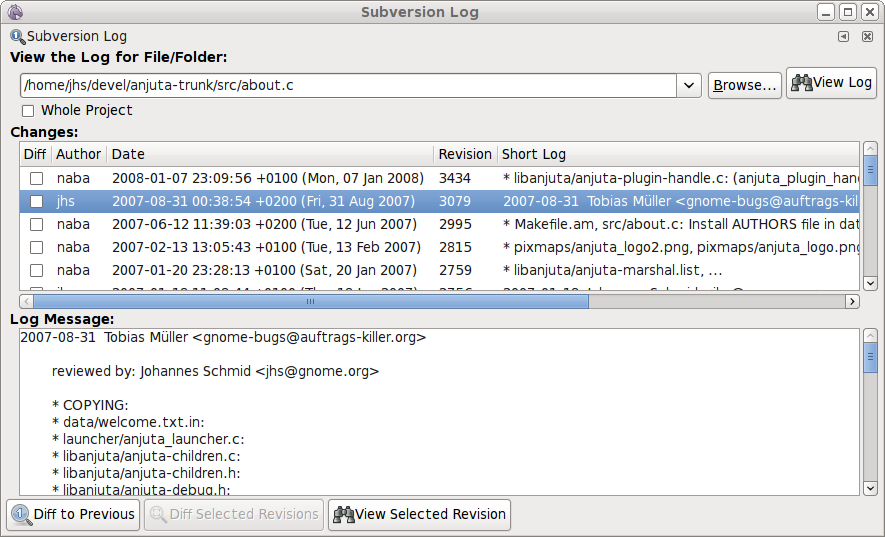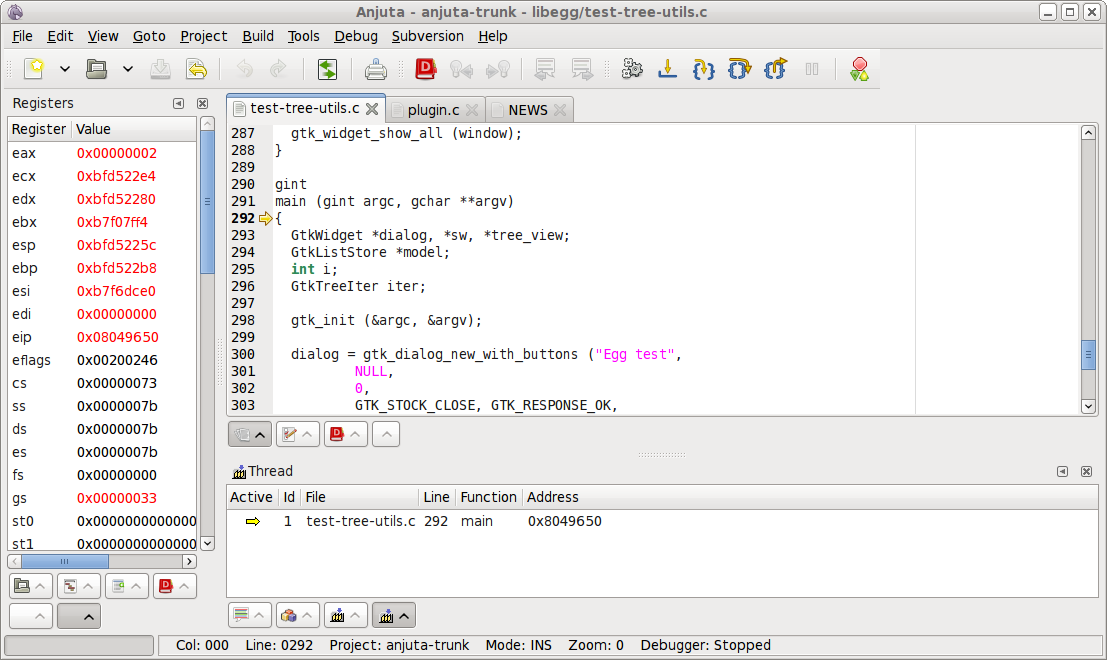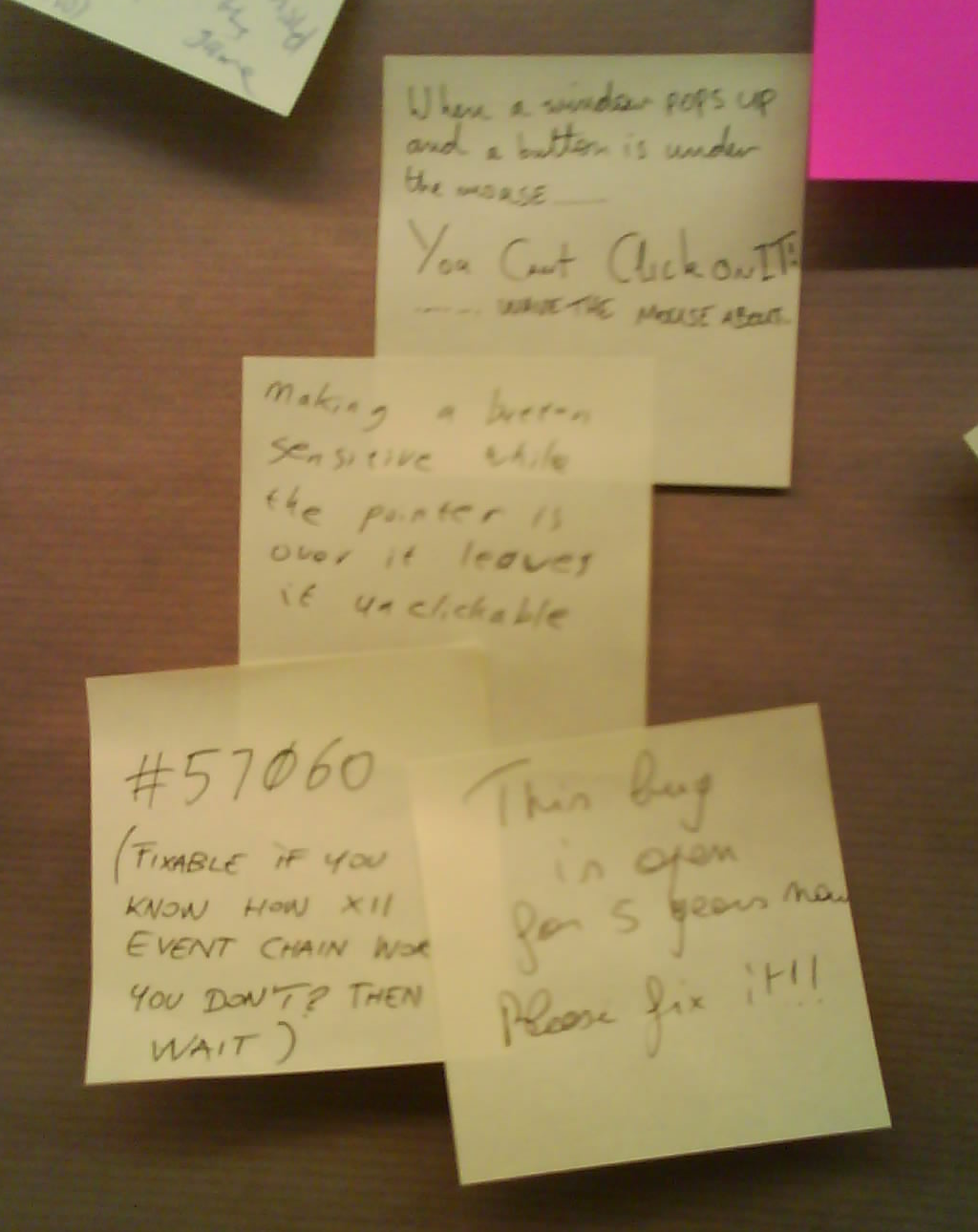Give more color to the world!
31. March 2008
When looking into screenshots of KDE, Windows Vista or MacOS X you will notice that they killed most of the grey from their Desktop and replaced it by colors or black. None of the themes is absolutely great but they all look very pretty and modern.
I am a really bad artist but when I look at our Clearlooks or Ubuntu Human themes I feel they are very drab. This is not about usability which is definitely great but just about the impression you get the first time you fire-up your GNOME Desktop. Everything grey, grey panels, grey window, grey taskbar, etc. Too much grey. Too much 90’s.
Of course grey has the advantage of being a neutral color but couldn’t we set some colored accents on the Desktop? Has everything to be clean, cold and neutral?
As I said before, I am bad artist and won’t be much help on this topic but might anybody want to add a bit more color to the clearlooks theme? The clearlooks engine is really rocking but I think we could gain a much better user impression with more and better colors. I searched on art.gnome.org but did not find anything that could fill this gap for me.
Anjuta Python-Binding
20. March 2008
Sébastien put up a nice website for the Anjuta Python-Bindings!
No more excuses not to write plugins!
Anjuta 2.4
15. March 2008
So, I haven’t yet written about our new release, the first one that is included in mainline GNOME. Partly motivated by Miguels’s post on MonoDevelop (which would actually share a lot of code with anjuta in case they hadn’t rewritten all the libraries in C#) I will present the new and improved features. Some were already mentioned in an older post.
Editing
Code editing is probably the most essential part of an IDE. While it’s pretty unlikely to convert people using vim/emacs to an IDE we at least try to make people happy that have used IDEs on other operating system or are coding using GEdit. There have been plenty of improvements in code completion and auto-indentation in this release and it should work pretty well for C/C++ now. We always look for people to write language-support plugins for more languages (yeah, it’s easy…). This release also features the latest and best version of GtkSourceView.
In addition we also improved the way to quickly search in a file using the new “Quick Search Bar”. (c) of this is probably from the vim/emacs and firefox developers, but why shouldn’t we copy it if it’s good!
UI Design
With this release we made a big step towards better glade integration also thanks to the glade-3 developers. The old and ugly “Glade”-menu is now gone and instead the “File” and “Edit” menu items will now also work on the opened glade file. And the glade file is displayed like any other source file in the central editor window.
But there is still room for improvements!
Version Control
The Subversion plugin was improved in many ways and it a pleasure to use now. It gives you much better control over operations then the command line frontend. You can for example select which files to commit, resolve conflicts and view logs now in the GUI:
The great work on subversion plugin was done by James Liggett (who is looking for a part-time job in case you need a talented GTK+ hacker…).
Debugger
With this release, the debugger doesn’t suck any more. You can debug your code with nearly all features available from gdb, inspect variables, set breakpoints, set watches, etc. And it’s rocking stable now and should make your live on killing bugs much easier:
Thanks!
Thanks to everyone who made this release possible, especially, Naba, Sébastien, Massimo, James, Tom, Rob and all the translator who fought this 1700 string monster (and reported all these l10n bugs).
Future
Anjuta follows the GNOME approach to try to keep things simple and our Roadmap reflects that. The goal is to make the existing features perfect before adding yet another. Of course that does not mean we are not interested in new plugins. Everybody who wants to contribute is highly welcome, especially for supporting more languages.
FOSDEM and GTK+ bugs
26. February 2008
FOSDEM was great fun and I had a great time with Jürg and the Swiss Vala Gang.
Here is a photo from the “What you dislike” part of the GNOME wall (sorry for the bad quality):
Would be cool if the Gtk+ Hackweek would result in a fix.
And if someone wants to fix the anjuta top-crasher (which is a gdl/gtk+ bug), review the patch at bug #467698 – Thanks!
Update: I did not write that note but the bug number is #56070. Thanks to andre and ebassi for pointing out!
svn:externals for noobs!
20. February 2008
As I am usually far to lazy to RTFM I had to learn how to add externals definition to subversion the hard way. But as other might probably need it, too, here is how it works (mind the dot at the end…):
svn propset svn:externals "<directory name> -r<revision> http://svn.gnome.org/svn/yourmodule/trunk/your_directory" .
The problem is that after that command it will not work because you have to commit the property change first:
svn commit -m "Changed external property"
So here is the final example:
svn propset svn:externals "eggtoolpalette -r853 http://svn.gnome.org/svn/libegg/trunk/libegg/toolpalette/" .
svn commit -m "Added eggtoolpalette"
svn update
And now you will have eggtoolpalette revision 853 in your tree. Thanks to herzi for helping me solving this problem on IRC.
Ubuntu Packaging, Anjuta, Glom, i18n
29. January 2008
Joining the recent discussion about Ubuntu packaging policies I would really prefer if they would update their versions to the stable branch. For us developers it’s a lot of work to backport things to the stable branch and fix the major bugs in it. We do that because we don’t want to force people to use unstable versions and because the stable version has lots of users and therefore lots of testing. In general it is unlikely that a x.0 version will ever be released without some minor/major bugs because the development version has never enough testers and something will be missed. Anyway, we do more stable releases for the one and only reason that distributions can update their packages and give their users better software. If you don’t trust us that our new stable version won’t brake everything than we really can’t help you that much.
Anjuta 2.3.3 was released yesterday and this will mean that UI should now be frozen. We did a lot of bug-fixing in the last weeks. Thanks to all those people testing and reporting bugs and writing patches. Also thanks to my two GHOP Students, Philipp Kerling and Boleslaw Kulbabinski for their work and I hope to see future constributions from them. [EDIT] Forgot that I wanted to ask for some volunteer artists to have a look at #511000 and maybe also #510047.
In the meantime I have been working on the Glom drag & drop stuff for Openismus. Unfortunately there is still nothing that could be shown but be sure that I will post a screencast once it is finished.
There has been a lot of discussion about locking upstream translations in Launchpad. Many translation teams agreed here but we probably have to sent some official request to the Launchpad people. I hope that is no big deal as we usually have a good relationship with Ubuntu.
GtkSourceView 2.1 in Anjuta
5. January 2008
After Paolo Borelli, Paolo Maggi and others helped a lot in adding support for marks in GtkSourceView 2.0 (#487098), I was finally able to update Anjuta to use the new and much nicer version. The obligatory screenshot:
Please also notice the new symbol-db plugin on the right-hand side which is constantly getting better thanks to Massimo Cora’ and should be end-user ready within some weeks. We are also very pleased that OpenedHand is supporting us with a patch.
For those interested, I also opened a new GHOP task for anjuta.
Happy coding!
New year – new laws
2. January 2008
This is maybe a reply to Mathias Blog:
The new year brought a bunch of new regulations in Germany (or at least in some states of Germany as we have a quite annoying federal system which makes most things even worse):
- Smoking is now prohibited in all public buildings and all bars/restaurants/disco in Bavaria (and some other states while it is still allowed elsewhere). I like that much personally and it is sad that Germany is more or less the last country in europe having installed such a strict anti-smoking law.
- All internet traffic connection data in Germany is now stored for at least 6 months to fight
terrorismcivil rights. I always admire George Orwell for his vision as he died in 1950 not even knowing an “internet”. Anyway, there is a complaint of unconstitutionality and hopefully it will succeed. But for now, if you happen to use the internet in Germany – watch out.
Other than that the new year started quite good (on top of a church tower…). So, happy new year to everybody (excluding most politicians).
Dell Ubuntu Laptop
14. December 2007
Two weeks ago I bought my first real Linux notebook after my old HP nx6110 already was fully linux-compatible but still had Windows XP preinstalled.
So after booting up my new Dell Inspirion 6400 the Ubuntu installation wizard popped up asking me for username, password and timezone and I found a standard Ubuntu GNOME Desktop. As many others have already complained about, Dell did not install 915resolution and thus the display was 1024×768 instead of 1280×800 which was of course quite easy to fix. Until now, they still ship Ubuntu 7.04 but I hope they will update to the new version soon because it’s a bit like shipping Windows XP without SP2 while security updates are of course installed.
The next step was to update to Gutsy which is of course as “update-manager -d” and worked without any problems. I also enjoyed the new codec-loading featurs of totem a lot.
What works:
- Suspend-to-Disk
- Suspend-to-RAM
- All multimedia key except the rather useless “Media Direct” key which should launch the laptop directly into (Windows) Media Player
- WLAN
What not works:
- After Suspend-to-Disk NetworkManager hangs
- After Suspend-to-Ram sometimes the keyboard does not respond (sleep and wake-up again usually fixes it) and in rare cases the display is not switched on.
In general quality and battery capacity seem very good and speed is ok as well as the low price. I hope Dell will improve Linux-integration for the next models to get a good out-of-the-box Linux feeling.
Hardware applet
19. November 2007
When playing with my new bluetooth hardware I was very pleased that it was supported out of the box. Anyway, I also missed something that would give me some indication that the hardware is working. (e.g. the first I did was to check dmesg)
When you look a Windows, they have those tiny notifications telling you that the new hardware was detected (or that it is not working or whatever). I think we should also have something like that. We now have HAL und dbus and I shouldn’t be that difficult to implement though I have no idea how this works in details. So take this as a proposal or tell me that it already exists (I didn’t find it):
There should three modes of operation:
1. Hardware is plugged in and supported
- Tell the user “Detected xy – new hardware is now working” (alexl pointed out that we should not do this as it is obvious. I would prefer to have this notification for the first time the hardware is attached).
- Propose some common operations: Open files for an USB-Stick, F-Spot for a digital camera, gnome-scan for a scanner, etc. Of course with a notification and not with an ugly centered dialog like Windows.
2. Hardware is supported but needs configuration
- Show enough information that the user can complete the configuration
- If there is no wizard to do this in a user friendly way, at least point the user to a (distro-specific) tutorial or at a place where he/she probably could find help.
3. Hardware is unsupported
- Point the user to a distro-specific update tool to search for a driver (=> PackageKit comes in mind…)
- If there is really no driver, ask the user to report a feature request, based on the device id. This should be saved in a database to see which drivers are needed by many people.
The most obvious case are of course USB devices but maybe also stuff like pcmcia and bluetooth could be detected that way. I think this would make hardware support on linux a lot more user-friendly. Personally I neither have the knowledge nor the time to implement that but maybe someone likes the idea!






